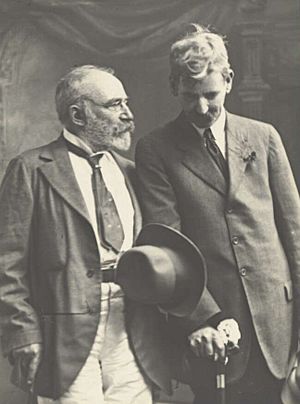J. F. Archibald facts for kids
Quick facts for kids
J. F. Archibald
|
|
|---|---|

J. F. Archibald (left) with Henry Lawson
|
|
| Born |
John Feltham Archibald
14 January 1856 |
| Died | 10 September 1919 (aged 63) Sydney, New South Wales, Australia
|
| Resting place | Waverley Cemetery |
| Monuments | Archibald Fountain, Hyde Park, Sydney |
| Nationality | Australian |
| Other names | Jules François Archibald; Archie |
| Occupation | Accountant; Journalist; Entrepreneur |
| Known for | Bequest to enable establishment of the Archibald Prize |
|
Notable work
|
|
Jules François Archibald, known as J. F. Archibald, was a very important Australian journalist and publisher. He was born John Feltham Archibald on January 14, 1856. He was a co-owner and editor of The Bulletin magazine. This magazine was very influential in Australian politics and literature. Archibald is also famous for creating the annual Archibald Prize, a major art award.
Contents
The Life of J. F. Archibald
Early Life and a New Name
J. F. Archibald was born into an Irish Catholic family in a place called Kildare. Today, this area is known as Geelong West, Victoria. His birth name was John Feltham Archibald. Later in his life, he changed his first names to Jules François. He did this because he loved everything French.
His friends often called him "Archie." They admired his great skills in journalism and his sharp understanding of literature. He was also known for being a good cook!
Starting The Bulletin Magazine
Archibald worked in many different jobs when he was younger. He was an accountant, a journalist for a Melbourne newspaper, and even a miner. In 1878, he moved to Sydney.
In Sydney, he teamed up with John Haynes and William Macleod. On January 31, 1880, they launched a new weekly paper. It was called The Bulletin. This paper shared news about politics, business, and literature.
Building a Magazine for Australian Talent
In 1882, William Henry Traill joined as a partner. Archibald then spent two years in London. When he returned in 1886, The Bulletin was struggling. Archibald decided to buy out the other partners.
With Archibald in charge, The Bulletin became Australia's top place for writers and artists. It featured poets, cartoonists, and authors of stories and jokes. Archibald spent almost all his time working on the magazine. He decided to let readers send in their own contributions. For 16 years, the magazine shared his strong, independent Australian views.
Later Years and Lasting Legacy
In 1902, Archibald's health began to decline. He stepped down as editor but still kept control of the magazine. He then started a new monthly magazine called The Lone Hand.
Soon after, his health got worse, and he spent several years in a hospital. Even from there, he kept writing. In 1907, he published a book about how The Bulletin started.
Archibald's health never fully recovered. In 1914, he sold his share in The Bulletin. He passed away in Sydney on September 10, 1919. He is buried in Waverley Cemetery.
In his will, Archibald left money for two important things. These are how most people remember him today:
- The Archibald Fountain in Sydney's Hyde Park. He wanted a French artist to design this fountain.
- The Archibald Prize for portrait painting. This is now Australia's most famous art prize.

